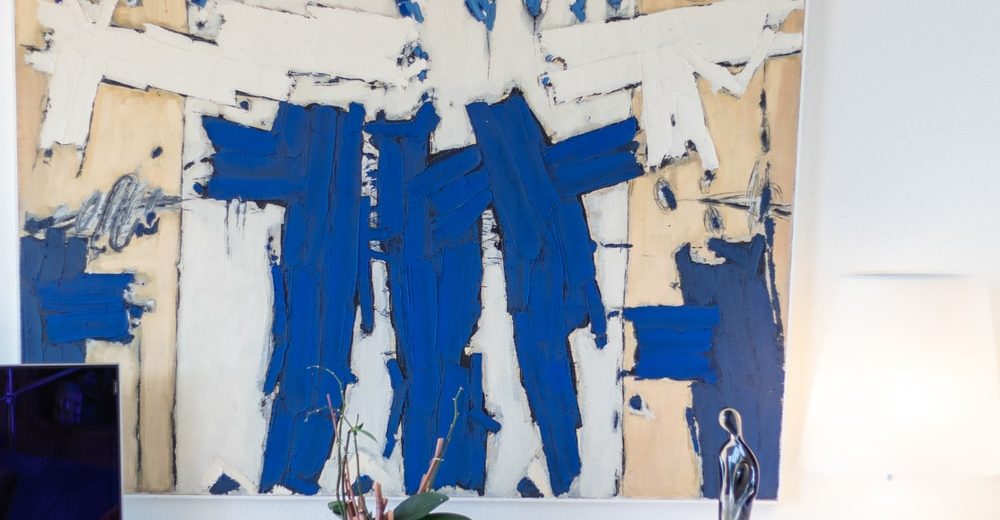Hello, Fabulistas!
I’m back in conversation with our Resident Expert in Art, Elizabeth Sadoff , and I’m excited to share the stage with her once again. If you enjoyed learning about her journey into the art world in our first discussion , here’s a deeper look into the life and process of an art advisor. You’ll get a sneak peek into the goings on of the art world, as well as some expert insight into the collection process. Get ready to begin your collection journey!

Contemporary Art for the Contemporary World
Robin: Hello again Elizabeth! Pleasure to have you back here with me.
Elizabeth: It’s mutual, Robin.
Robin: Can you talk a bit about current trends? What kind of art are people drawn towards?
Elizabeth: In my world, gestural painting/abstract expressionism is still the current trend, as largely expressed by contemporary practitioners. Because I specialize in working with budding collectors, this genre of painting is emotional and seems to be a good place to jump into the world of art when one is starting out. I also see a great deal of attention being paid to what some people would call “street art” or “graffiti art.” Trying to categorize this genre is a losing proposition for the most part, but we have to try! Art which brings elements from street’s visual lingo is catching on big time.
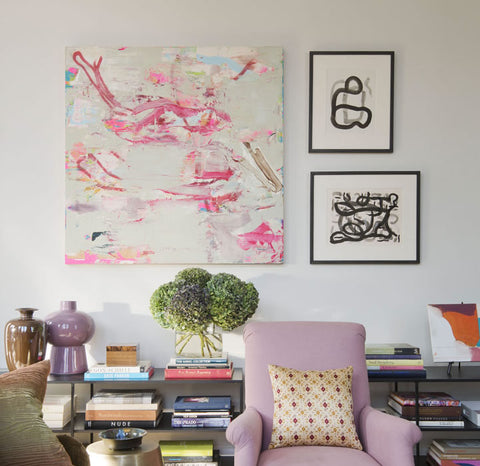
Robin: Are you personally drawn towards a particular style of art? What embodies a sense of timeless for you?
Elizabeth: When I worked at the David Findlay Jr. Gallery, we focused mainly on mid–century Abstract Expressionist artists, specifically artists you would call “second generation.” The Club was a term coined to describe the 200 some New York artists of the 40’s and 50’s who dug their respective heels in to define a new painting form which would detour away from the dictates of European painting. There was a coming together of artists exploring each other’s work, supporting each other, fighting with each other, all taking place at the now legendary Cedar Tavern in downtown NYC. A lot of artists saw their work going into permanent museum and corporate collections. As time went by, however, fewer and fewer artists remained “recognized,” an unfortunate outcome of the contemporary art world’s hierarchy. The Abstract Expressionist movement fascinates me because it is super timeless – it really turned the entire art world around, specifically in New York. It has been hard to move out of that aesthetic over time and is constantly revisited by contemporary painters.
Robin: Could you give us an example of an artist that you really admire? Does his/her artwork represent the work that people are drawn to?
Elizabeth: Philip Guston was extremely courageous . He participated in the Abstract Expressionist zeitgeist then fell out of its thrall, returning to figurative painting, but in sardonic, comic book characterizations. Cigar smoking, bulbous characters became his hallmark, as well as his lampooning of the Ku Klux Klan. He turned out work that was witty and caustic and not well received during its time. This, however, is one place where my clients don’t look. If they continue to look over time, I believe they could develop a taste for figurative artwork. Personally, I have come back to the figure, as well as still life and landscape, but don’t press my newly minted collector clients to embrace this subject matter. I feel that representation has been given short shrift over the years, and that is the way art trends go.
The Artful Process of Art Selection
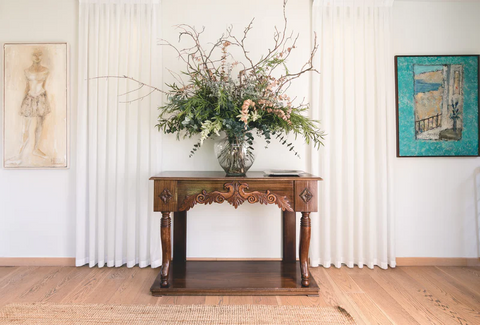
Robin: What is it like for a beginner art collector to work with you?
Elizabeth: If I am working with a client, there are no right or wrong questions or descriptive words! If I show someone a work of art they don’t respond to, they can simply say so. Once a client informed me that he wanted to return home each night to a living room that felt like a high-end spa. I use this example a lot because it was so freeing for me… I could begin to search for art that would evoke this feeling. This process is step by step – essentially, I want to give the client license to get to the point of articulating something key regarding what they are seeking.
Robin: In the process of art selection and placement, how do you treat each space differently? And then, there is also the added layer of the client’s own personality. How do you bring them together with art?
Elizabeth: It’s a many-phased challenge. The virtue of having worked with many interior designers over time is that I truly understand that good placement depends on proximity to other work, furniture, the color of the walls, et cetera, et cetera. It needs to sing in its chosen spot – there is a necessary dialogue between the artwork and other elements of that space. Now, if the design process follows after art selections, we have way more latitude to switch priorities, but the same considerations hold true – we need to establish a comprehensive aesthetic experience in a room.
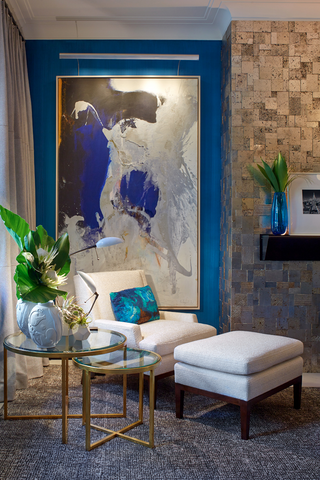
Elizabeth: The short answer is “yes,” within reason, and here’s what I mean. Way back when, I worked for a well-established gallery in Manhattan where we ostensibly focused on helping clients purchase artwork. In our “white cube” space, anything would look great. While we certainly insisted that the work should be taken to our clients’ homes “on approval” so that they could verify that the piece(s) worked for them in situ, a question we never asked right at the get-go was: “what does the room or rooms where you are considering placing the art look like?” or “do you have a picture(s)?”
Over the past 12 years working as an independent art advisor I have learned bucketloads from my collaborations with interior designers. Designers taught me early on that the setting can make or break the excellence of a work of art. When a design project is in its final stages, it becomes critical that the room speak to the artwork and conversely, the artwork speaks to the room. This is why I now ask for all nature of atmospheric details when I am initially engaged in an art search – not just scale restrictions – and you will need to consider this as well when you search for a work of art that not only deeply resonates with you but will be the jewel in the crown of your design concept!
Representing the Underrepresented
Robin: You are known to bring mid-career artists to the fore and introduce them to unfamiliar collectors. What has been the most interesting aspect of this process?
Elizabeth: In my experience with most clients, if they have engaged interior designers, or even if they approach me independently, they typically have the means to make acquisitions easily, but lack confidence in making decisions because they believe that there is either a right or a wrong decision that can be made about art. They read about work represented by prominent Blue Chip galleries and become stymied. These clients need to become aware of the trove of talent “out there” that they wouldn’t normally find on their own and learn to trust their own gut reactions. The most interesting aspect of this process to me is slowly drawing out from these prospective collectors what they respond to and seeing them realize what that is as they are revealing it. I show them a relatively random assortment of images to begin with (pictures are much easier to respond to than descriptive words), and these clients often surprise themselves. They may not know why or what they are responding to, but something hits them. This is when the magic begins to happen, and I love this! The new paradigm of how art is sold needs to be democratic and user-friendly, not exclusive and off-putting. This is what so many of us are fighting for so that the art market can flourish for all stripe of client and artist.
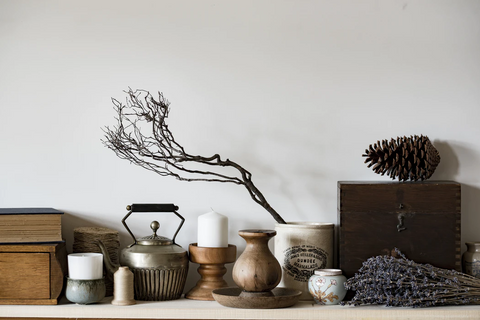
The World of Collecting
Collecting really is a learning process, and there is no right or wrong answer. I know I got quite a bit of insight into the world of collecting, and I hope you gained the confidence to explore the world of possibilities in front of your art collection journey. Elizabeth approaches art and collecting in a way that’s fresh and inclusive, something I absolutely admire . Stay tuned for my next conversation with her for tips and tricks on bringing a piece of art into your interior spaces—one that reflects you as a person.
XOXO,
Robin

